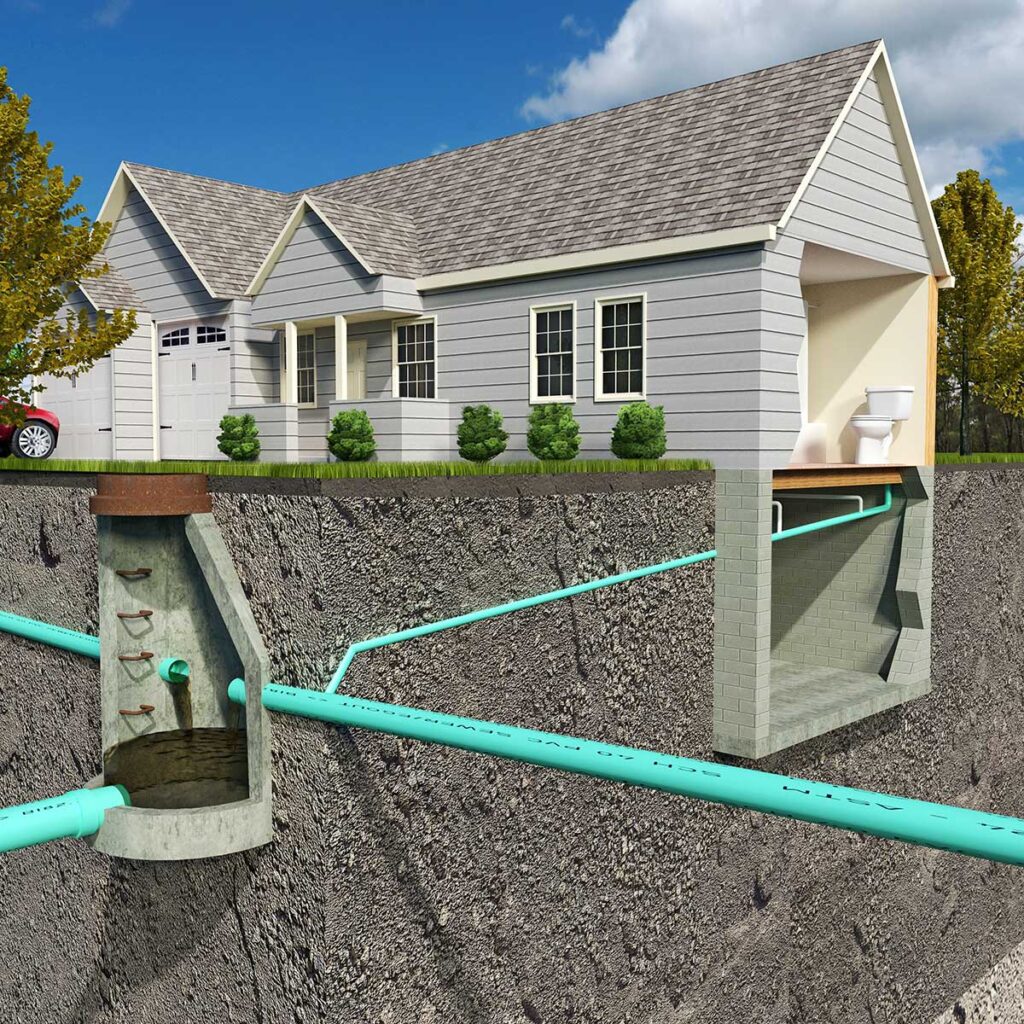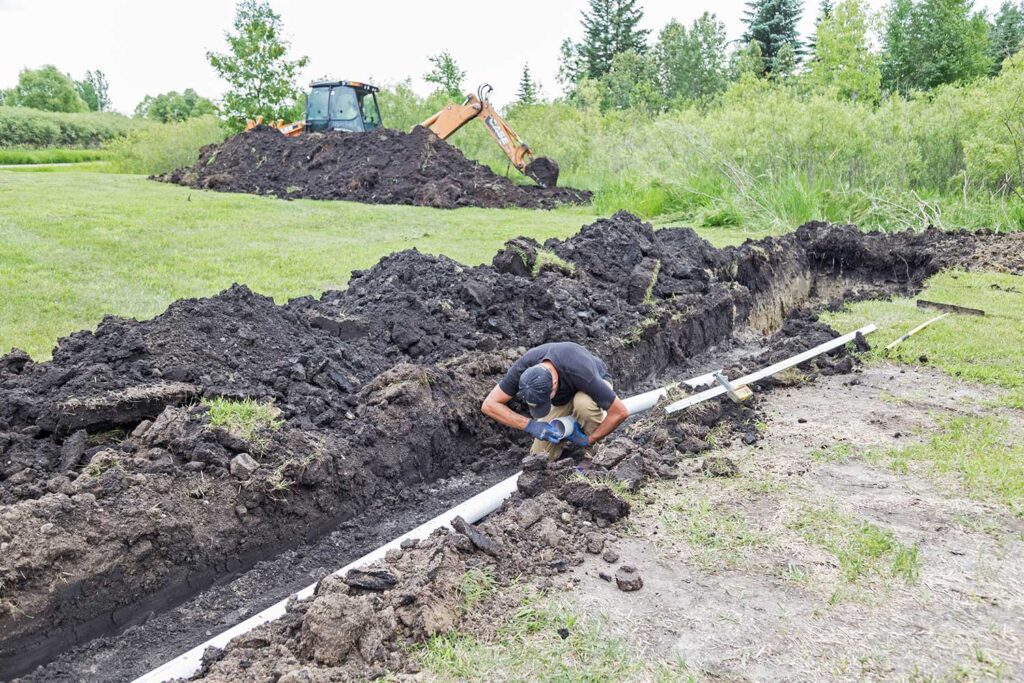Septic Systems and How They Work.
No matter where we live, we rely on septic systems to work efficiently and with little maintenance. Knowing what system you have, where it is located, and the system’s rating (maximum number of people supported), is vital. A perc test can also help in determining what type of system can be installed.
How Does a Septic System Work?
The most common type of septic system in rural areas is a conventional septic system. This system’s job is to remove waste from the home and dispose of it through the tank and drain fields. As waste is disposed from the home into the septic tank, water waste fills most of the tank and sludge goes to the bottom. Bacteria and enzymes in the tank help in breaking down sludge to create liquid waste. Liquid waste then moves to a pump chamber to be pumped and discharged into perforated pipes. The harmful bacteria and viruses are killed off before liquid is passed through drain or leach fields to be distributed back to soil and groundwater. It is important to not drive or build on the leach field as this could break the drain pipes or compact the soil, damaging the leach fields’ ability to effectively drain water, and potentially causing a backup into the home.

Required Septic System Maintenance is Important
Regular septic system maintenance, or pumping your septic system, prevents a buildup of solids, protecting the pump chamber and drain fields. If a buildup in your drain or leach field occurs, an array of problems can result, including expensive repairs to the tank and field, indoor plumbing, and possibly other areas inside your home.
Septic Service Timing
If a concrete septic tank is properly maintained and pumped as recommended, it should last approximately 40 to 50 years. If the tank is pumped too often, bacteria can reach the drain field which could cause clogs and failures. Tanks are usually pumped and inspected once every 3 to 5 years in Wisconsin. If electrical float switches, pumps, or mechanical components are present, those should be inspected annually.
Septic Service Providers and State Notifications
Having a regular service provider who is familiar with your specific septic system can be particularly beneficial, making scheduling your regular service visits, understanding your system, and noticing any potential concerns much easier. Property owners may receive notices via mail from the state, alerting them that it is time to have their septic tank pumped. Check with the septic service provider to see if they record the pump date, as this will ensure the state receives notice that the work has been completed. If a septic service provider does not notify the state, property owners may need to send the order and receipt to the state as evidence of service completion.
Perc Test: Testing soil percolation to determine water drainage rate
A perc test is suggested for anyone who is purchasing vacant land with the intention of building. It is also noted on a Vacant Land Offer to Purchase if a buyer wants a perc test contingent to the sale of the property. By stating this as a contingency, a buyer is protected from having to proceed with a land purchase in the event that soil is not suited for any type of septic system relative to building. Having soil tested determines whether a septic system can be installed and where it can be located, and this information can be used to design the right size and type of system best suited to the property. If the soil test does not pass for a conventional system, then a mound or holding tank will be recommended. A perc test can be done by septic system installers or by land surveyors.

The Four Main Types of Septic Systems
Conventional Septic System: In this most common system, noted above, a tank, distribution box, and drain or leach field are used. This system is most common in rural areas and requires adequate soil and a large area for the drain field. It is costly to install but offers relatively low maintenance with a 3 to 5 year pump schedule.
Mound Septic System: A mound-style system is used when there is poor or shallow soil, high groundwater, or shallow bedrock that is close to the surface. The drain or leach field is located just beneath the sand and gravel mound. The sludge stays inside the tank and the wastewater travels from the tank to a distribution box where it is then pumped to the mound in controlled amounts. From there, liquid travels at low pressure into distribution pipes that sit in sand fill. This process allows the water to trickle down through the entire mound, consisting of layers of sand and gravel, and eventually into the soil. A mound system relies on a pump to remove the wastewater. If the pump fails, the septic tank can back up quickly. This system is less expensive to install than a traditional conventional septic system as the trenches are not as deep.
Holding Tank Septic System: In this system, a large tank temporarily holds sewage until the system can be pumped by a septic service provider. The system does not drain into the soil, therefore it takes up a much smaller area. This system is scalable for residential installation, and an appropriate size can be selected depending on household size. Holding tanks are used when soil conditions cannot withstand any other type of septic, or can be used temporarily until a new septic system can be installed. The cost with this type of septic system is largely calculated by the number of maintenance cleanouts required.
Aerobic Septic System: An aerobic septic system is a more advanced type of system that uses water, oxygen, and bacteria to treat wastewater. Known to maximize space on a property, this system works by pressurizing oxygen-rich air directly into the tank to help break down sludge. This style usually requires a smaller tank size and fewer required service cleanouts. This sceptic system is generally the most expensive type.
Septic Systems: Signs of Failure
There are a few signs that may indicate that your septic system is failing or is in need of repair. A clear indicator is sewer backup into your home. Prior to that, you may notice slow drains or gurgling noises in your pipes as you flush the toilet or use the shower. There could be standing water, soggy spots, or lush grass near the tank or drain field. Sewer odors inside or outside the home can also be a possible sign of failure. If you experience any of these issues, it may be time to call a septic service provider to diagnose any problems and correct them.
Common Preventatives for Septic Systems
When you own a septic system, it is recommended by septic installers and service providers to carefully manage which household cleaners are used. You may be advised against using bleach, iron removers and other cleaners. Garbage disposals are also not recommended, as adding food wastes can stress or clog your septic system. Lastly, using less toilet paper or low-ply toilet paper can help prevent clogs.
Questions about septic systems?
Understanding or choosing a septic system can be complex, with factors such as cost, design, and maintenance requirements. Each system has pros and cons. We recommend researching the types of systems and how each works. Additionally, contacting a septic service provider or installer can make the selection process easier. Knowing about your particular septic system will support your efforts to keep the system in good working order for many years to come.

We can provide you the expertise you’re looking for! Our real estate agents offer superior communication along with area and market knowledge.
Stop by or give us a call at Route 63 Realty in Hayward, Wisconsin 715-558-7846. Our staff are readily available to help answer any questions you may have.
“Bringing Buyers and Sellers Together One Route at a Time!” – Route 63 Realty

